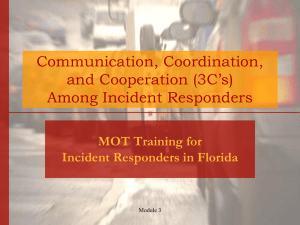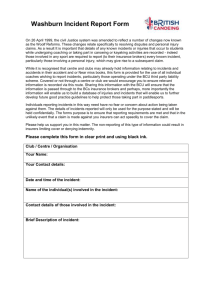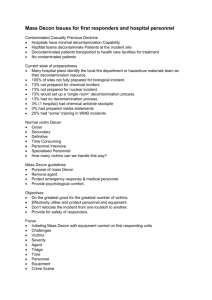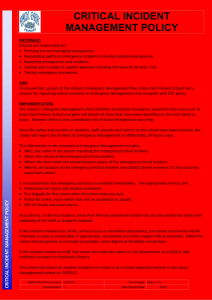Response to Incidents Involving Weapons of Mass Destruction
advertisement
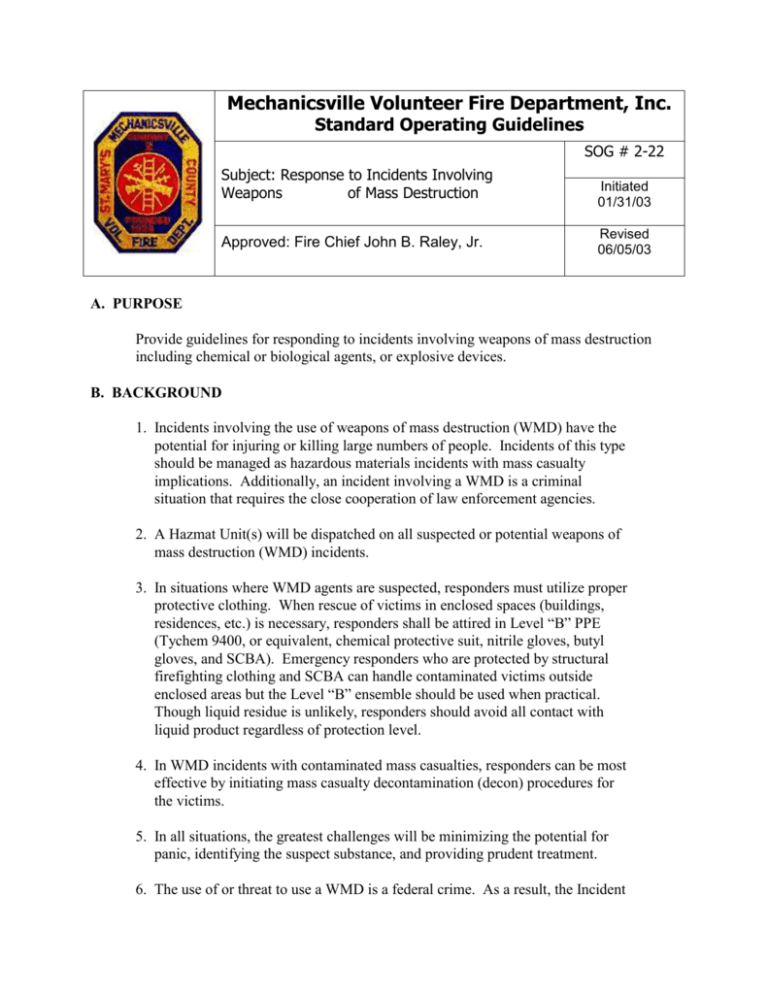
Mechanicsville Volunteer Fire Department, Inc. Standard Operating Guidelines SOG # 2-22 Subject: Response to Incidents Involving Weapons of Mass Destruction Approved: Fire Chief John B. Raley, Jr. Initiated 01/31/03 Revised 06/05/03 A. PURPOSE Provide guidelines for responding to incidents involving weapons of mass destruction including chemical or biological agents, or explosive devices. B. BACKGROUND 1. Incidents involving the use of weapons of mass destruction (WMD) have the potential for injuring or killing large numbers of people. Incidents of this type should be managed as hazardous materials incidents with mass casualty implications. Additionally, an incident involving a WMD is a criminal situation that requires the close cooperation of law enforcement agencies. 2. A Hazmat Unit(s) will be dispatched on all suspected or potential weapons of mass destruction (WMD) incidents. 3. In situations where WMD agents are suspected, responders must utilize proper protective clothing. When rescue of victims in enclosed spaces (buildings, residences, etc.) is necessary, responders shall be attired in Level “B” PPE (Tychem 9400, or equivalent, chemical protective suit, nitrile gloves, butyl gloves, and SCBA). Emergency responders who are protected by structural firefighting clothing and SCBA can handle contaminated victims outside enclosed areas but the Level “B” ensemble should be used when practical. Though liquid residue is unlikely, responders should avoid all contact with liquid product regardless of protection level. 4. In WMD incidents with contaminated mass casualties, responders can be most effective by initiating mass casualty decontamination (decon) procedures for the victims. 5. In all situations, the greatest challenges will be minimizing the potential for panic, identifying the suspect substance, and providing prudent treatment. 6. The use of or threat to use a WMD is a federal crime. As a result, the Incident Commander should immediately request that the ECC notify the FBI and request that agents respond to the scene. 7. Responders may also be pre-staged as a result of a credible threat as identified by law enforcement authorities. In this instance the Fire Department Incident Commander shall report to the law enforcement command post and confer with the law enforcement official in charge. C. RESPONSIBILITIES FOR RESPONSE TO A CHEMICAL RELEASE 1. First Arriving Unit a. Primary Responsibility Size up the situation based on the following factors: 1) Signs and symptoms exhibited by the victims including: Tearing Eyes Myosis Nausea and Vomiting Muscular Convulsions Note: The same or similar symptoms will be visible in multiple victims. 2) Physical signs at the incident scene including: Unusual odors (sharp, musty, fruity, like garlic or newly mowed hay, etc.) Report of a small explosion or a gaseous cloud release 3) Accounts of onlookers or victims b. Duties 1) Don SCBA and PPE. For all responders working in the warm zone AWAY from the hot zone, the greater health risk is respiratory. Donning SCBA offers maximum protection, and structural firefighting ensembles will protect the skin. Personnel shall don Level “B” chemical suits (supplied to each response unit) whenever possible. 2) Seal off the area and deny exit or entry. Using fire line tape, rope, or other suitable material, cordon off the area to ensure that potentially contaminated victims do NOT vacate the area and are directed to the decontamination corridor (see establish decon subsection below), and that passersby who are not contaminated do NOT enter the contamination area. 3) Establish Command The Incident Command Post should: Be positioned upwind and uphill from the incident site (hot zone). Provide access and egress to the site. Be easily identified by all personnel-especially non-fire agencies. 4) Assemble Resources If not already dispatched, request the following from ECC: Haz Mat Incident Response Metropolitan Medical Strike Team (MMST) Sheriff’s Office and Maryland State Police (MSP) Duty Officers or designees (to Command Post) 5) Assess the Need for Additional Resources An incident of this size and type could potentially require several alarms and more than one Hazardous Materials Team. Other special resources to consider requesting are: Additional ALS and BLS units Buses for victim transport Additional law enforcement units (local and state) FBI Terrorism Task Force 6) Establish Mass Casualty Decon (for chemical exposures) One of the most important functions First Responders can perform is to establish a decontamination corridor for victims to proceed through prior to being triaged for medical treatment and transport, if necessary. The docon corridor shall be managed as a sector and will be under the direction of a Decon Sector Officer assigned by the Incident Commander. 2. Incident Commander a. Primary Responsibilities Incident Strategy and Management Personnel Accountability Scene Safety b. Duties 1) Upon arrival, assume command and establish the Command Post in a location that is upwind and uphill from the incident site; is easily accessed and exited; and can be easily identified by all agencies (law enforcement; state, and federal). Command shall be operated in a unified mode upon the arrival of law enforcement agencies’ personnel. 2) Prepare to coordinate with many representatives from multiple local, state, and federal agencies (FBI, Public Works, Environmental Services, Police Departments, Maryland Department of Emergency Management, Local EMA officials, etc.) 3) If the incident involves the use or suspected use of a weapon of mass destruction, the FBI has jurisdiction as the lead federal agency. Federal assets can be accessed through the Bureau’s representatives. 4) Evaluate the situation, including the tactical objectives initiated prior to arrival. 5) Identify the overall strategy, develop the incident action plan, and assign personnel and companies consistent with the action plan and standard operating procedures. 6) Develop an effective incident management organization through the use of the St. Mary’s County Incident Command System. 7) Provide and communicate tactical objectives. If necessary, prompt reports from operational units to confirm the status of tactical assignments. 8) Evaluate the incident action plan and revise as necessary. Report situation updates to ECC approximately every twenty (20) minutes. 9) Provide for the continuity, transfer, and termination of Command. 10) Initiate, Maintain, and control the communications process. 3. Hazardous Materials Sector a. Prepare to make hot-zone entry for recon, detection, and monitoring. 1) All entries shall be made in Level “B” ensembles until the following information is known: Identification of type of agent Toxicity/Concentration (IDLH Level) Atmospheric oxygen available Presence of flammable gases 2) Units can “downsuit” upon a decision from the IC, in coordination with the Haz Mat Sector Officer, based upon the situation information obtained as specified in the paragraph above. 3) A separate emergency decon corridor under the direction of the Haz Mat Sector Officer shall be established for Haz Mat team use only. b. Report findings to IC. 1) Report the situation findings based on the information obtained as specified above. 2) Report the number of victims, their symptoms and conditions, and any other information that may be needed. 4. Decon Sector (Victim) Coordinate the formation of the mass casualty decon corridor as described in Attachment 1. a. Actual configuration of the corridor is dependent upon the incident site, available space, and the water supply. b. Ensure an adequate water supply for the decon line. c. The decon corridor will require a large area. It should be located in the warm zone as close as possible to the victim’s original location to avoid having them travel too far to enter the corridor. d. Communicate with Command concerning the number of victims and the need for assistance with non-ambulatory victims. 5. EMS Sector a. Identify and establish triage, treatment, and transport areas. These areas should be located so those decontaminated victims can be triaged, treated, and if necessary, transported as efficiently as possible. b. Assess the need for additional EMS units and activate them as necessary. c. Initiate triage, provide treatment for decontaminated victims and transport them to medical facilities or other appropriate locations as necessary. d. Initiate contact with area medical facilities to advise them of the incident and the potential for large numbers of chemically poisoned or biologically contaminated victims to be transported to their facilities. Identify transportation needs (buses, ALS/BLS units, etc.) and relay these requirements to the Incident Commander. D. SCENE MANAGEMENT FOR CHEMICAL INCIDENTS Most chemical scenarios will likely occur in the larger urban areas (Lexington Park, Pax River, etc.); therefore adequate operational space should be available. The management of patients is a critical component for successful mitigation. 1. Establish the triage and treatment line immediately following the mass casualty decon (MCD) corridor. 2. Ensure that victims do NOT have to pass through the warm or hot zones to proceed to the transportation area. 3. Establish control areas as part of the triage sector. Victims who do not need immediate transport can be sent to these areas, while those requiring immediate transport can be moved to the transportation area. 4. Identify building lobbies or other large areas that can be used to temporarily house victims in cold weather (cold weather is defined as temperatures below 55 degrees). E. SCENE MANAGEMENT FOR BIOLOGICAL INCIDENTS Most incidents involving biological agents will likely become noticeable through a public health emergency and will require the coordination of EMS responders, emergency room physicians, and Public Health Officials who notice the health effects of an exposure throughout the community. Though the involvement of emergency responders may still be significant, the deployment of resources will not require the type of scene management associated with a chemical incident. There are, however, those situations in which a threat to release a biological agent will require the action of emergency responders. 1. If the incident is a situation in which a credible threat to institute such an incident has been made, personnel should immediately contact the Battalion Chief for further guidance. An example of such a scenario would be the receipt of mail indicating that a biological agent (such as anthrax) has been spread. Some factors to consider in evaluating these situations include: a. Written content of the letter or package b. Appearance of the alleged agent (color, composition, density, etc.) as compared to a known substance. c. Odors that are obvious without anyone actually sniffing the package. In such cases, because of the physical properties of biological agents, it is likely that the alleged biological agent is a non-toxic substance. 2. All verified or suspected WMD situations should be handled with caution. In the case of a biological threat there are available treatments for most biological agents and the time between exposure and the need for treatment is as long as 24 hours. This gives emergency responders the opportunity to accurately identify an agent before initiating treatment. Some elements to consider in possible contamination situations are: a. Whether the substance has the physical properties of the alleged agent. b. Whether the agent has been exposed to sunlight or the environment for more than three (3) hours. (Most letters take two to three days from mailbox deposit to delivery.) c. Minimizing the number of persons exposed to the letter or package. d. Assessing the need for additional resources without excess. e. Whether decon is necessary. Decontamination for a suspected biological agent should only be initiated if the victims came in physical contact with the substance. In this instance the victims should remove their outer clothing and personal articles and should shower with soap and water. (Use of hazmat decon showers is discouraged for this decon; use of indoor showers is preferred and acceptable.) Personal articles should be placed in double plastic bags and saved as evidence for law enforcement authorities. f. Potentially exposed victims should not be transported to the hospital unless the substance is confirmed as a biological agent. Fire Department personnel should acquire the names and telephone numbers of potentially exposed victims so that notifications can be made regarding the outcome of substance testing. F. SCENE MANAGEMENT FOR INCIDENTS INVOLVING EXPLOSIVE DEVICES. Units responding to incidents involving explosive devices must assess the scene carefully. Particular attention must be paid to the fact that small explosive yield (magnitude) devices can be used as dissemination devices for WMD materials. Observing the appearance and signs/symptoms of victims may indicate whether a chemical material has been released. 1. Pre-explosion Considerations: a. The size of the suspected device, which will aid in determining evacuation distances. These judgements and subsequent evacuation efforts should be coordinated with the Police Department. b. A device that has not yet detonated is a law enforcement responsibility. However, if the potential exists that the device may detonate within an occupied area, consideration should be given to requesting additional or specialty units and should be coordinated through a unified command. 2. Post Explosion Considerations: a. If the incident is believed to be the result of a terrorist action, consideration should be given to the potential for secondary devices. Unusual packages and objects (unidentified boxes, packages, suitcases, etc.) located in unusual places (at or near the front door, standpipe, hydrant, etc.) should be viewed with suspicion and avoided until confirmed as not dangerous. b. Assessing the location of the majority of damage will indicate where the explosive device was located and where the most severely injured victims may be located. c. Establishing a large area for triage, treatment and transportation is required to provide adequate working space for responding EMS units to treat victims. Additional space will also be required for special response teams (MMST, USAR, DMAT, etc.) and should be considered in the incident action plan. G. ESTABLISHING A MASS CASUALTY DECON CORRIDOR (MCD) 1. Position Engines approximately 20-25 feet apart, aligned in parallel, with pump panels facing away from each other. Side discharges shall be aligned directly across from each other. 2. Mount 2-inch handline nozzles on both side discharges. Alternatively, the master fog stream nozzle(s) can be used if set on the lowest setting. 3. Ensure that the nozzles for patterns are set to approximately 30 to 40 degrees. 4. Position the front, 1-inch pre-connect nozzle to point into the corridor. 5. Pump engines at a low enough pressure to provide adequate flow into the corridor without harming the victims as they traverse the corridor. 6. Position the Ladder Truck or Quint master stream to fill the end of the corridor with a large-volume spray (as specified above for the Engines). 7. Initial decon operations should being with 1 or 2 engines but 4 engines should be utilized as they arrive to maximize the operation. The decon officer should account for this in his or her plan.

